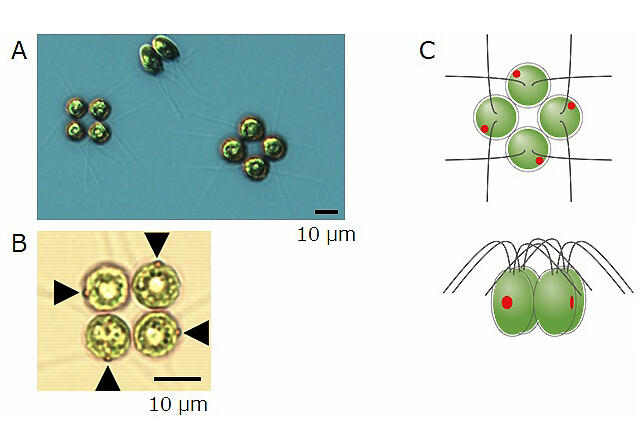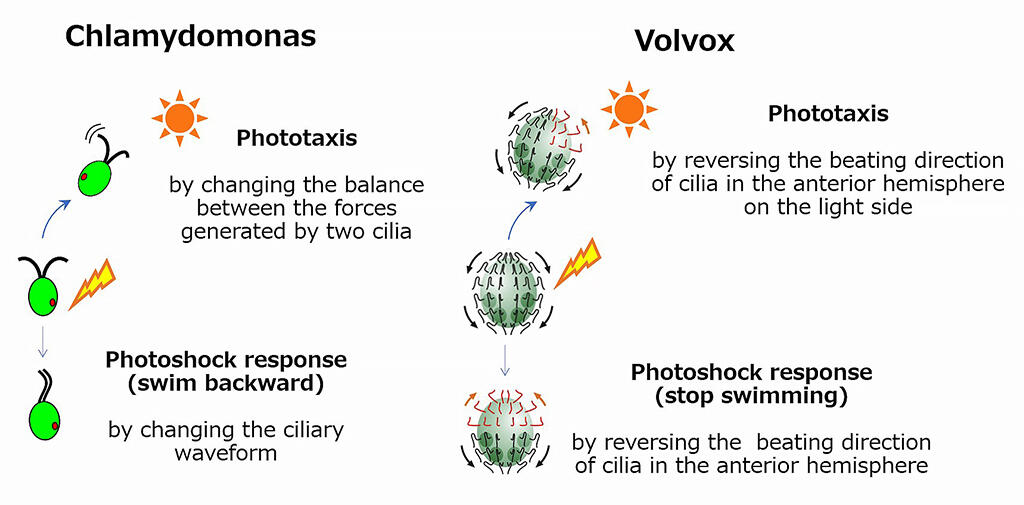The research group comprised Asuka Tanno, graduate student at the Department of Life Science and Technology, School of Life Science and Technology, Tokyo Institute of Technology (at the time of research); Associate Professor Ken-ichi Wakabayashi, Laboratory for Chemistry and Life Science, Institute of Innovative Research, Tokyo Institute of Technology; and Associate Professor Hisayoshi Nozaki, School of Science, The University of Tokyo (at the time of research). Professor Noriko Ueki of the Hosei University Science Research Center and others revealed that the multicellular green alga Tetrabaena socialis, which is made up of only four cells, has a survival strategy different from that of closely related green algae in response to strong light stimuli.

Provided by Tokyo Institute of Technology
The research group has been studying the mechanism underlying the photobehavior, including phototaxis and photoshock responses, of the model unicellular green alga Chlamydomonas for many years. As an extension of this study, the group clarified the mechanism underlying the photobehavior of Volvox, which is the largest of the multicellular organisms with Chlamydomonas-type unicellular ancestors. In this study, the group members focused on Tetrabaena socialis, a multicellular organism with the smallest known number of cells, and proceeded with their research.
Tetrabaena socialis, an alga belonging to the order Volvocales and family Chlorophyceae, swims using cilia. Light is an important energy source for photosynthetic organisms, such as green algae. However, intense light poses a threat, and so, the photoreactive behavior of swimming in search of a light environment suitable for survival is essential for swimming algae.
According to Associate Professor Wakabayashi, "Tetrabaena socialis does not show photoreactive behavior similar to Chlamydomonas or Volvox, irrespective of how it is stimulated by light. We had a hard time proving that it did not display this behavior."

Provided by Tokyo Institute of Technology
The research group found that when Tetrabaena socialis was stimulated by light, its photoreceptive function was lost and it did not display photoreactive behavior. However, the group discovered that the alga had a high ability to eliminate excessively strong light energy as heat. It is thought that the alga lost its photoreactive behavior but gained a high photoprotective ability during the process of multicellular evolution; this feature allowed the alga to survive in the natural world. The high photoprotective ability (function to protect the photosynthetic device of chloroplasts from strong light) of Tetrabaena socialis, which cannot show photoreactive behavior, suggests that the previously obscure role of photoreactive behavior in algae is to protect chloroplasts.
Associate Professor Wakabayashi said, "In the future, we would like to clarify whether this idea can be applied to other organisms by comparing the photoreactive behavior and photoprotective ability in other swimming algae. Additionally, we want to explore the possibility of improving the efficiency of the large-scale culture of oil-producing algae, which is currently attracting attention for clean energy, by clarifying the reason behind the high photoprotective ability of Tetrabaena socialis at the molecular level."
This article has been translated by JST with permission from The Science News Ltd.(https://sci-news.co.jp/). Unauthorized reproduction of the article and photographs is prohibited.




